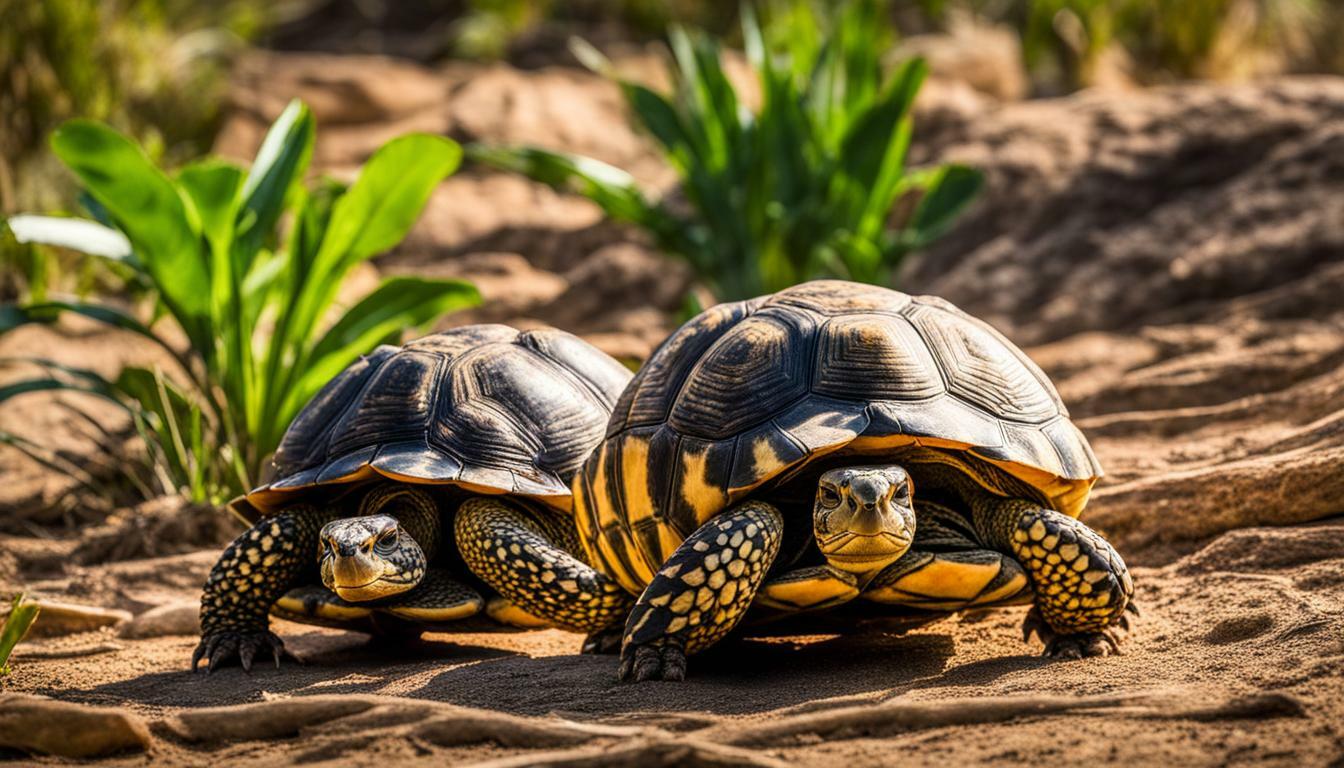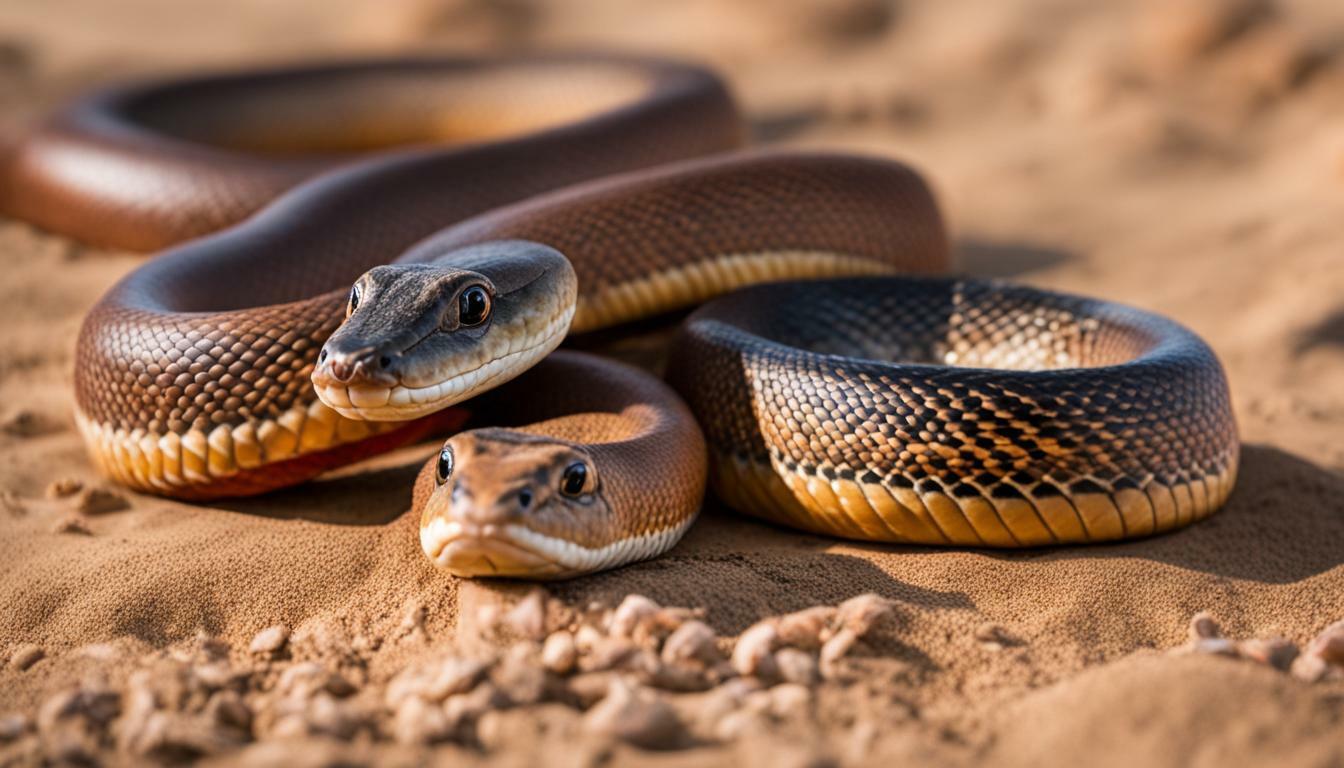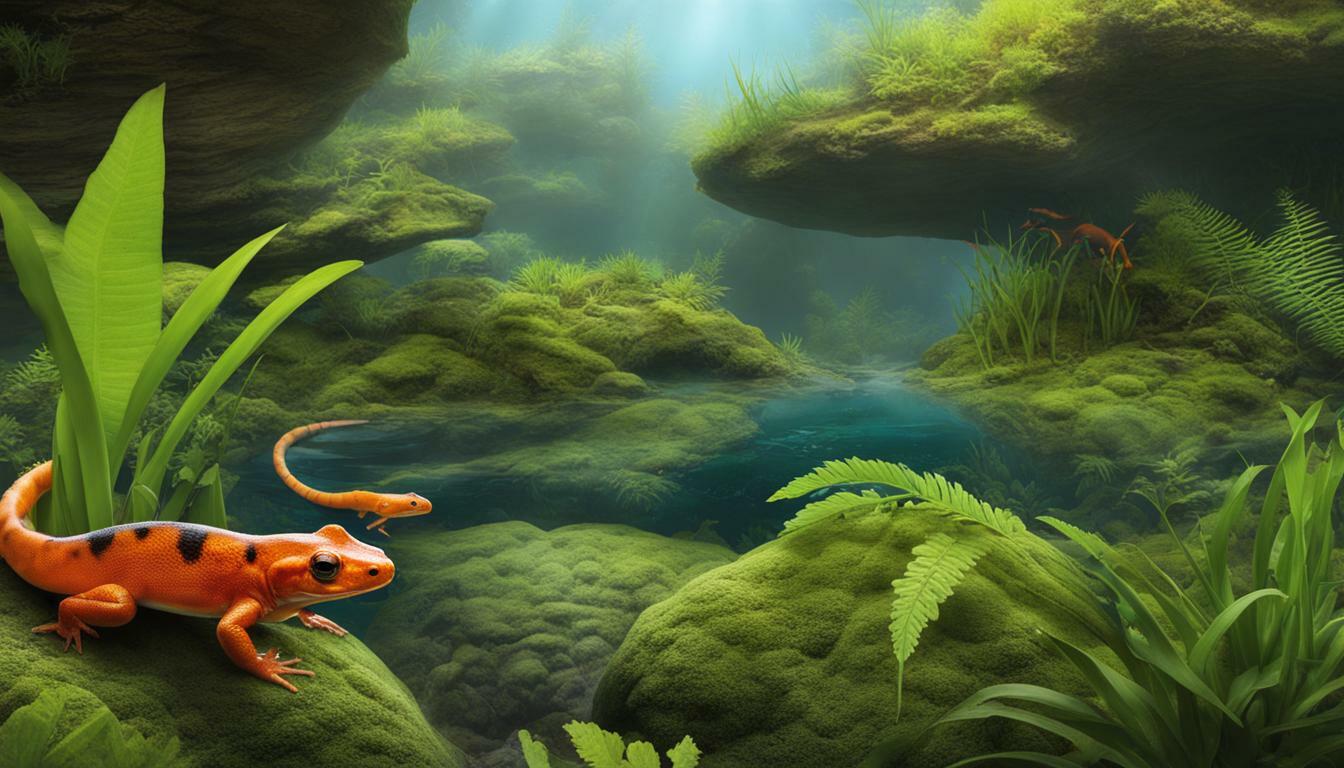Leopard tortoises and Sulcata tortoises have several notable differences that set them apart from each other. Leopard tortoises are found in Somalia, Ethiopia, and South Africa, while Sulcata tortoises are native to Central and West African deserts. Both species can live for over 100 years. Sulcata tortoises are more social and owner-friendly, while leopard tortoises are more shy and may bite when handled. In terms of appearance, leopard tortoises have cream-to-yellow skin with black spots, stripes, or blotches, while Sulcata tortoises have yellowish-brown skin. Size-wise, Sulcata tortoises are larger and heavier than leopard tortoises. Sulcata tortoises are more active and capable of digging large tunnels, whereas leopard tortoises are less active. Both species have similar diets, consisting of fruits, weeds, and dry grass. They do not hibernate but become less active during the winter. When it comes to housing, Sulcata tortoises require larger enclosures than leopard tortoises. Both species require similar conditions to their natural habitat, including humidity, lighting, and heating. In terms of price, Sulcata tortoises are generally more expensive than leopard tortoises. Sulcata tortoises are beginner-friendly, while leopard tortoises are more suitable for intermediate or advanced tortoise lovers. Sulcata tortoises can be kept in groups, but leopard tortoises have a more docile and sociable nature. It is possible to keep Sulcata and leopard tortoises together, but proper care should be taken to provide enough food and space for both species.
Key Takeaways:
- Leopard tortoises and Sulcata tortoises have different origins and habitats.
- Sulcata tortoises are more social and owner-friendly, while leopard tortoises are shy and may bite when handled.
- Leopard tortoises have cream-to-yellow skin with black spots, stripes, or blotches, while Sulcata tortoises have yellowish-brown skin.
- Sulcata tortoises are larger and heavier than leopard tortoises.
- Both species have similar diets and require specific care conditions.
Origins and Behavior
Leopard tortoises and Sulcata tortoises have different origins and exhibit distinct behaviors in their natural habitats. Leopard tortoises are found in Somalia, Ethiopia, and South Africa, while Sulcata tortoises are native to Central and West African deserts. These geographic differences contribute to variations in their preferred environments and behaviors.
In their natural habitats, leopard tortoises are known for their shy and solitary nature. They tend to spend most of their time browsing for food and seeking shelter in thick vegetation or burrows. Leopard tortoises are more independent and may exhibit defensive behavior, including biting, when handled or threatened. On the other hand, Sulcata tortoises are more social and owner-friendly. They are known for their friendly and docile nature, often enjoying interaction with their owners.
“Leopard tortoises are more independent and may exhibit defensive behavior, including biting, when handled or threatened.”
Understanding the natural behaviors of these tortoise species is crucial for their care and well-being in captivity. While leopard tortoises may require more patience and time to gain their trust, Sulcata tortoises are generally more comfortable with human interaction. However, it’s important to note that individual tortoises may have unique personalities and behaviors, so it’s essential to observe and understand their specific needs and preferences.
| Tortoise Species | Origins | Behavior |
|---|---|---|
| Leopard tortoise | Somalia, Ethiopia, South Africa | Shy, solitary, defensive |
| Sulcata tortoise | Central and West African deserts | Social, friendly, docile |
Appearance and Size
Leopard tortoises and sulcata tortoises have distinct appearances and vary in size. Leopard tortoises have cream-to-yellow skin with black spots, stripes, or blotches, giving them a unique and eye-catching appearance. On the other hand, Sulcata tortoises have yellowish-brown skin, which blends well with their natural desert environment. These differences in skin color make it easy to distinguish between the two species.
Size-wise, Sulcata tortoises are larger and heavier than leopard tortoises. Adult Sulcata tortoises can reach lengths of up to 30 inches (76 cm) and weigh anywhere between 80 to 200 pounds (36 to 91 kg). In comparison, leopard tortoises are smaller, with adult males typically measuring around 16 to 18 inches (40 to 46 cm) in length and weighing between 30 to 50 pounds (14 to 23 kg). Female leopard tortoises are slightly smaller, reaching lengths of 13 to 16 inches (33 to 40 cm) and weighing around 25 to 40 pounds (11 to 18 kg).
Table: Comparison of Appearance and Size
| Tortoise Species | Appearance | Size (Length) | Size (Weight) |
|---|---|---|---|
| Leopard Tortoise | Cream-to-yellow skin with black spots, stripes, or blotches | 16 to 18 inches (40 to 46 cm) (Males) 13 to 16 inches (33 to 40 cm) (Females) |
30 to 50 pounds (14 to 23 kg) (Males) 25 to 40 pounds (11 to 18 kg) (Females) |
| Sulcata Tortoise | Yellowish-brown skin | Up to 30 inches (76 cm) | 80 to 200 pounds (36 to 91 kg) |
As evident from the table, Sulcata tortoises surpass leopard tortoises in terms of both length and weight. However, it’s important to note that the size of tortoises can vary depending on various factors such as diet, genetics, and overall health. Therefore, individual tortoises may deviate slightly from these average sizes.
Despite their size differences, both leopard tortoises and sulcata tortoises are equally fascinating and captivating creatures. Whether you prefer the striking appearance of the leopard tortoise or the majestic presence of the Sulcata tortoise, both species have their own unique charm that can make them wonderful additions to your tortoise family.
Diet and Care
Providing proper nutrition and care is essential for the health and well-being of leopard tortoises and sulcata tortoises. These fascinating creatures have specific dietary requirements that should be met to ensure their growth and overall health.
Both leopard tortoises and sulcata tortoises are herbivores and have similar diets. Their main diet consists of fruits, weeds, and dry grass. It is important to provide a variety of fruits, such as apples, bananas, and berries, to ensure they receive a balanced intake of nutrients. Weeds, such as dandelion greens and plantain leaves, are also essential for their diet. Additionally, providing dry grass or hay helps with digestion and provides the necessary fiber.
It is important to avoid feeding leopard tortoises and sulcata tortoises foods that are toxic or harmful to them. These include foods that are high in protein, such as meat and dairy products. It is also important to avoid feeding them foods that are high in oxalates, such as spinach and rhubarb, as these can interfere with the absorption of calcium.
When it comes to the care of leopard tortoises and sulcata tortoises, it is important to recreate their natural habitat as closely as possible. This includes providing them with a spacious enclosure that allows for plenty of movement and exercise. The enclosure should have a substrate that mimics their natural environment, such as soil or sand. It is important to maintain proper humidity levels, as well as provide suitable lighting and heating to ensure their well-being.
| Leopard Tortoise Diet | Sulcata Tortoise Diet |
|---|---|
|
|
“Providing proper nutrition and care is essential for the health and well-being of leopard tortoises and sulcata tortoises.”
In conclusion, leopard tortoises and sulcata tortoises have similar dietary needs and require proper care to thrive. It is important to provide them with a variety of fruits and weeds, as well as a suitable enclosure that mimics their natural habitat. By meeting their dietary and care requirements, you can ensure the long and healthy lives of these amazing creatures.
Price and Suitability
Understanding the cost and suitability of leopard tortoises and sulcata tortoises is important for potential tortoise owners. When it comes to price, sulcata tortoises tend to be more expensive compared to leopard tortoises. The larger size and longer lifespan of sulcata tortoises contribute to their higher price tag. On the other hand, leopard tortoises are generally more affordable, making them a budget-friendly option for those interested in owning a tortoise.
Both leopard tortoises and sulcata tortoises have their own unique characteristics that make them suitable for different types of tortoise keepers. Sulcata tortoises are known for being beginner-friendly, as they are more social and interactive with their owners. They can be kept in groups and enjoy human interaction. However, it’s important to note that sulcata tortoises require larger enclosures due to their size, so ample space is necessary to accommodate their active nature.
Leopard tortoises, on the other hand, are better suited for intermediate or advanced tortoise lovers. They are more docile and shy in nature, which may not make them the best choice for owners seeking a highly interactive companion. However, leopard tortoises can still form a bond with their owners over time and can be a delight to observe and care for. They require smaller enclosures compared to sulcata tortoises, making them a more manageable option for tortoise enthusiasts with limited space.
| Tortoise Species | Price Range | Suitability |
|---|---|---|
| Leopard Tortoise | Affordable | Intermediate/Advanced Tortoise Lovers |
| Sulcata Tortoise | More Expensive | Beginner-Friendly |
Conclusion
In conclusion, while leopard tortoises and sulcata tortoises have their own unique characteristics, both make fascinating and rewarding pets for tortoise lovers. Leopard tortoises are found in Somalia, Ethiopia, and South Africa, while Sulcata tortoises are native to Central and West African deserts. Both species have impressive lifespans, often living for over 100 years.
Sulcata tortoises are known for being more social and owner-friendly, making them a great choice for those who want a tortoise that enjoys interaction. On the other hand, leopard tortoises tend to be shyer and may bite if handled. It’s important to consider your own comfort level and ability to handle these differences in behavior.
When it comes to appearance, leopard tortoises have cream-to-yellow skin with black spots, stripes, or blotches, creating a stunning and distinctive look. Sulcata tortoises, on the other hand, have yellowish-brown skin. Both species are beautiful in their own right, so it ultimately comes down to personal preference.
Size-wise, Sulcata tortoises are larger and heavier than leopard tortoises, capable of reaching impressive sizes. This means they require more space and a larger enclosure compared to their leopard counterparts. Sulcata tortoises are also more active, known for their ability to dig large tunnels, while leopard tortoises are generally less active.
In terms of diet and care, both species have similar dietary requirements, consisting of fruits, weeds, and dry grass. Neither species hibernates, but they do become less active during the winter months. When it comes to housing, both tortoise species require conditions that mimic their natural habitats, including proper humidity, lighting, and heating.
Price-wise, Sulcata tortoises are generally more expensive than leopard tortoises due to their larger size and longer lifespan. However, it’s essential to consider the long-term financial commitment and ensure you can provide the necessary care for either species.
In terms of suitability, Sulcata tortoises are beginner-friendly and can make a great choice for those new to tortoise keeping. Leopard tortoises, on the other hand, are more suitable for intermediate or advanced tortoise enthusiasts who have experience with reptile care. Sulcata tortoises can be kept in groups if given enough space, while leopard tortoises have a more docile and sociable nature.
While it is possible to keep both Sulcata and leopard tortoises together, it is crucial to provide enough food and space for both species. Additionally, proper care and attention should be given to each tortoise’s individual needs to ensure their well-being and happiness.
FAQ
What are the differences between Leopard Tortoises and Sulcata Tortoises?
Leopard tortoises are found in Somalia, Ethiopia, and South Africa, while Sulcata tortoises are native to Central and West African deserts. Sulcata tortoises are more social and owner-friendly, while leopard tortoises are more shy and may bite when handled. In terms of appearance, leopard tortoises have cream-to-yellow skin with black spots, stripes, or blotches, while Sulcata tortoises have yellowish-brown skin. Size-wise, Sulcata tortoises are larger and heavier than leopard tortoises.
What are the natural habitats and behaviors of Leopard Tortoises and Sulcata Tortoises?
Leopard tortoises are found in Somalia, Ethiopia, and South Africa, while Sulcata tortoises are native to Central and West African deserts. Sulcata tortoises are more social and owner-friendly, while leopard tortoises are more shy and may bite when handled. In terms of appearance, leopard tortoises have cream-to-yellow skin with black spots, stripes, or blotches, while Sulcata tortoises have yellowish-brown skin. Size-wise, Sulcata tortoises are larger and heavier than leopard tortoises.
What are the physical characteristics and size differences between Leopard Tortoises and Sulcata Tortoises?
Leopard tortoises have cream-to-yellow skin with black spots, stripes, or blotches, while Sulcata tortoises have yellowish-brown skin. Sulcata tortoises are larger and heavier than leopard tortoises.
What are the dietary requirements and care needs of Leopard Tortoises and Sulcata Tortoises?
Both species have similar diets, consisting of fruits, weeds, and dry grass. They do not hibernate but become less active during the winter. When it comes to housing, Sulcata tortoises require larger enclosures than leopard tortoises. Both species require similar conditions to their natural habitat, including humidity, lighting, and heating.
How do the prices and suitability of Leopard Tortoises and Sulcata Tortoises compare?
Sulcata tortoises are generally more expensive than leopard tortoises. Sulcata tortoises are beginner-friendly, while leopard tortoises are more suitable for intermediate or advanced tortoise lovers. It is possible to keep Sulcata and leopard tortoises together, but proper care should be taken to provide enough food and space for both species.
Can Leopard Tortoises and Sulcata Tortoises be kept together?
It is possible to keep Sulcata and leopard tortoises together, but proper care should be taken to provide enough food and space for both species.



